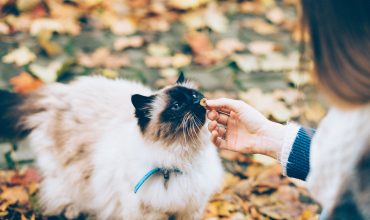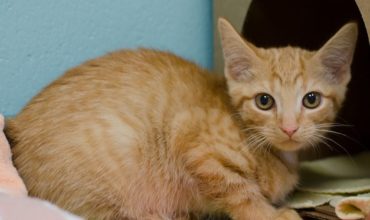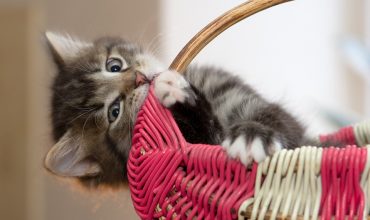How to Transition Your Cat to an Indoor/Outdoor Lifestyle Want to give your cat some fun in the great outdoors? A slow start is key! Every cat is different; this could take from two weeks to a month or more. It’s important that your cat become acclimated to their indoor home, first. So please make sure kitty has a good amount of time inside with his family before beginning the process to acclimate them to indoor/ outdoor living. When your cat is feeling confident and calm in their indoor environment, they’ll be much more confident in their new indoor/ outdoor
Read More
Archives for general behavior
Training Cats with Positive Reinforcement
[print-me] Training your cat has important benefits. You’re stimulating his body and his mind, which helps keep him healthy. And spending time together means you’re strengthening the bond you share. It’s helpful to work with behaviors that are less than desirable and you can also teach fun tricks like wave and fetch, or teach him a range of useful behaviors like sit, stay and to come when called. Reward behaviors that you want Simply put, if you want your cat to repeat a behavior, reward that behavior. It’s important to make sure that you’re rewarding the behavior you want and
Read More
Adopting a Fearful Cat
[print-me] Why Are Some Cats Fearful? Fearful behavior in cats can be caused by various factors. Insufficient exposure to humans and/or a variety of stimuli during kitten hood as well as traumatizing events in their lives can teach them to react fearfully towards people or new situations. Cats can also be genetically predisposed to being fearful. How to Introduce a Fearful Cat to a New Home Fearful cats usually do best in relatively quiet homes. They are often not suitable for young children as children can easily scare them with loud noises or sudden movements. Many fearful cats slowly become
Read More
Petting-Induced or Overstimulation Aggression in Cats
[print-me] Many of us have had the pleasure of petting our cat, when all of a sudden; the cat bites your hand and runs away. This is called petting induced or overstimulation aggression. It’s a common behavior in many cats, and is something that can be both frustrating and frightening until you learn how to manage this behavior with your cat. What causes this behavior? Cats are normally not as social as dogs, nor do they have as much physical contact with others of their species. They may groom each other and sleep close to each other, but have few
Read More
Adopting a Fearful Kitten
[print-me] What Does “Fearful” Mean? A fearful kitten is generally one that has not had full socialization. If a kitten does not have much contact with people when it is between the ages of 3 weeks and 7 weeks, it is likely to be scared of strangers it meets. Depending on the individual temperament of the kitten, what it has observed from its mother, and how old it is, it may hiss, spit or strike out – or may simply attempt to run away. Some fearful kittens learn to trust people quickly, others can take a long time. This depends
Read More
Keeping Cats off of Countertops
[print-me] Why Do Cats Like to Climb? Cats climb for several reasons. They seek out high vantage points, like countertops and shelves, to survey their territory. They can leap onto bookshelves or scale curtains to escape from another household pet or from something that scares them. Tables and the top of the refrigerator often provide warm, sunny places to snooze. Cats can learn to patrol or “surf” countertops, stovetops and tables in search of tasty tidbits left behind. Alternatives to Climbing on Countertops and Tables It’s best not to stifle your cat’s normal jumping and climbing behavior. Your cat will
Read More
Unusual eating habits in dogs and cats
[print-me] Dogs and cats will sometimes eat socks, rocks or other objects, which may result in a variety of problems for both you and your pet. Not only can your possessions be destroyed or damaged, but objects such as clothing and rocks can produce life-threatening blockages in your pet’s intestines. Eating non food items is called pica. A specific type of pic is stool eating (either their own or that of another animal) and, while not necessarily dangerous to the animal, is probably unacceptable to you. Stool eating is called coprophagy. The causes of pica and coprophagy are not known. Many ideas have been proposed by various experts, but none have been proven or disproven. Such behaviors may sometimes be attention-getting behaviors. If engaging in one of these behaviors results in some type of social interaction between the animal and his owner (even a verbal scolding) then the behavior may be reinforced and occur more frequently. These behaviors may be attempts to obtain a necessary nutrient lacking in the diet, although no nutritional studies have ever substantiated this idea. They may also stem from frustration or anxiety. It’s possible behaviors begin as play, as the animal investigates and chews on the objects, then subsequently begins to eat or ingest them. It has been suggested that coprophagy is carried over from the normal parental behavior of ingesting the waste of young offspring. Some experts believe coprophagy occurs more often in animals who live in relatively barren environments, are frequently confined to
Read More
Positive Reinforcement: Training with treats and praise
[print-me] Positive reinforcement is the presentation of something pleasant or rewarding immediately following a behavior. It makes that behavior more likely to occur in the future, and is one of the most powerful tools for shaping or changing your pet’s behavior. Correct timing is essential when using positive reinforcement. The reward must occur immediately, or your pet may not associate it with the proper action. For example, if you have your dog sit, but reward him after he’s already stood up again, he’ll think he’s being rewarded for standing up. Consistency is also essential. Everyone in the family should use the same commands.
Read More
Rough play in a kitten or adult cat
Is your kitten or cat playing too rough? Here's what to do.
Read More
Managing scratching
[print-me] By nature, cats have a need to scratch objects in their environment. We know that cats leave their scent behind when they scratch things and that this is a means of letting the world know that they’re there… whether it is to warn another cat away or to invite them to play. They tend to go back to the same spots and scratch those spots repeatedly for this reason; it’s another way for them to mark their territory. Even cats who have been declawed will try to scratch things for this very reason! Scratching also happens in play, as
Read More













